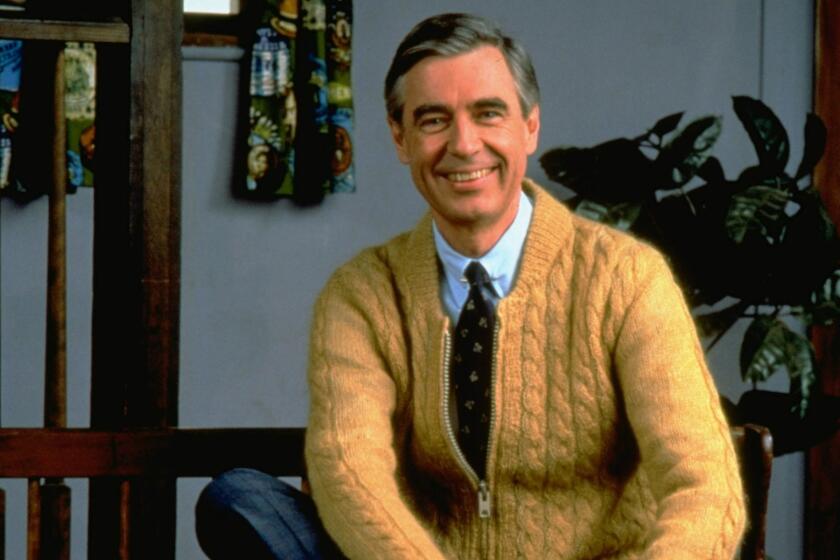How befriending Mister Rogers’ widow allowed me to learn the true meaning of his legacy
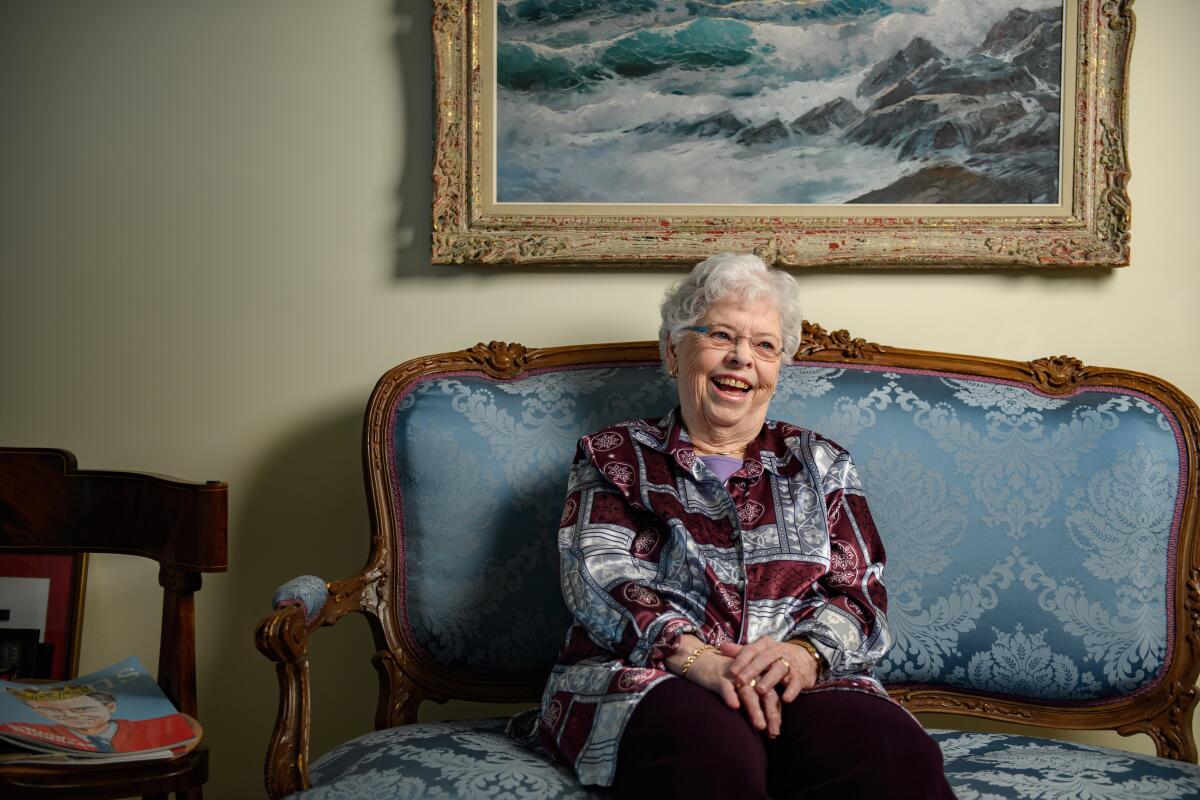
- Share via
Fred Rogers proposed to Sara Joanne Byrd in a letter. A letter she lost almost immediately in a flurry of excitement as she rushed to a pay phone to give him her answer: “Yes, yes, yes!”
Both 24, she just 11 days his senior, they were friends but not yet lovers. It was 1952 and they were in the midst of a long-distance courtship that began at Rollins College in Florida. She recalls being attracted to Fred, but they weren’t particularly physical with each other outside of the sorority and fraternity dances they attended together. Joanne — she dropped “Sara” early on, deeming it too stuffy — was raised in a Puritan home, and she was repulsed by her schoolmates who talked about “sucking face.” Any kissing she said she and Fred did was “pretty unpracticed.”
When Fred headed to New York after graduation for an apprenticeship at NBC — the first stop on his way to “Mister Rogers’ Neighborhood” — she stayed in Florida to get her master’s degree in music. They kept in touch through the mail, though they weren’t very good writers, Joanne says. Fred told Joanne about his hopes for the future — about the kind of people he wanted the two of them to become. Even though she didn’t know him all that well by the time he proposed, that’s what she clung to — the idea that this was a man with a strong moral center.
She still has most of the letters from their early courtship. They’re tucked in a tote bag that hangs by her favorite chair, so she can grab one when she wants to feel close to him. In the 16 years since Fred’s 2003 death, they’re the only token of his that she’s kept for herself.
Joanne is one of the primary stewards of Fred’s legacy. At 91, she is the chair emerita of Fred Rogers Productions and the Honorary Chair of the Fred Rogers Center for Early Learning & Children’s Media on the Saint Vincent College campus. Last year, the 50th anniversary of his seminal kids program, she participated in a PBS special about Fred, helped to promote a commemorative postage stamp with his face on it and was also part of Morgan Neville’s hit documentary “Won’t You Be My Neighbor?” She was also a key figure in the development of “A Beautiful Day in the Neighborhood,” the Marielle Heller-directed film that was released over the weekend in which Tom Hanks plays Mister Rogers.
“When Fred died, she wasn’t going to step in to be Mister Rogers, but she was going to step in,” said Bill Isler, who served as the president and CEO of Fred’s company for nearly three decades and is so close to the family that he named his two springer spaniels “Fred” and “Joanne.” “I think she is incredibly comfortable with it. They were married for over 50 years and raised two sons. Fred relied on Joanne. He would often say that if it wasn’t for Sara Joanne Byrd Rogers, the ‘Neighborhood’ probably would have never happened.”
Yet when the filmmakers behind “A Beautiful Day in the Neighborhood” approached Joanne to get her blessing on the project, Micah Fitzerman-Blue, who wrote the film with Noah Harpster, said, “She really only had one request: that we not treat her husband as a saint.”
She was keener on imparting to the writers just how funny Fred was. If the couple was out at an event that turned out to be bland, he had a go-to way of making her laugh: passing gas.
“He would just raise one cheek and he would look at me and smile,” she said, cracking herself up.
The movie tells the story of Fred’s relationship with Tom Junod, a journalist who was assigned to profile the television host for Esquire magazine in 1998. As a cynical investigative writer, Junod was initially hoping to uncover the dark side of the cheery public figure. But as Junod spent more time with him, Fred started to turn the questions on the writer himself, more interested in learning what made the journalist tick than revealing his own inner workings. In the years following the publication of the cover story, Fred and Junod kept in touch — migrating from written correspondence to email as he typed away on a lightweight laptop that Joanne had given him one Christmas.
It was over email that I developed my own relationship with Joanne. Our virtual pen pal communication began last summer, just after the release of Neville’s documentary. I’d done a brief phone interview with her, no more than 20 minutes. Less than a week later, a message popped up in my inbox. She’d tracked down my email address and sent a note to tell me that she’d enjoyed the story I had written.
I wrote back, and so our correspondence commenced. She called me by pet names: Dear, dearie, dearest, honeybun. Her notes — always bookended with the “Sent from my iPhone” tag — were animated with red and pink heart emojis. Sometimes, if we communicated via text message, she’d include her Memoji — a customizable avatar she’d created replete with her curly gray mop of hair, glasses and tooth gap.
She wrote about the weather, her health, her visits to see live music. When a new line of Mister Rogers sweaters came out, she told me she thought they sounded comfortable, but she didn’t want one: “I’m very warm-natured and sweaters make me too hot and itchy.”
Sometimes her emails would arrive in the middle of the night. Like me, Joanne was a night owl. She usually went to her bedroom around midnight, she said, “where I put on sleeping gear and then read until I begin to yawn seriously.” She often dozed off around 2:30 a.m., she said, making sure her friends never phoned her before 10 a.m.
“That is an almost 91-year-old’s kind of sleep schedule, I think,” she wrote last February, “though most of my peers seem to be morning people … hmmm.”
That winter, she wrote to me saying she hoped to meet me in L.A. — “your neighborhood,” as she called it — where she was planning to fly if “Won’t You Be My Neighbor?” was nominated for an Academy Award. When the documentary was snubbed she sent an update, noting the news was “disappointing and surprising,” but that “we just need to concentrate on the doc’s created mission — Fred’s legacy — and be grateful that can continue well beyond [the Oscars].”
Fred Rogers was anything but a glutton; his Thanksgiving shows were about hunger not just bounty, and he refused “to eat anything that had a mother.”
But there was still “A Beautiful Day in the Neighborhood.” The November premiere was planned for Fred’s native Pittsburgh, where much of Heller’s film was shot. I finally had a reason to meet Joanne.
“Be on the watch as you come from the airport to look at the city when you come out of the tunnel!!” she advised in her last message to me before my plane departed for Pennsylvania. “Spectacular even if it should be raining!!”
I had been told by many how integral Fred’s legacy was to the city. Stores at the airport sell T-shirts and baby onesies with his face on them, and a 7,000-pound, 11-foot bronze statue of him sitting and tying his sneakers rests next to the Allegheny River. During a film shoot last year, Tom Hanks told me, locals were quick to impart how important Fred was to the area — in other words: Don’t screw this up.
“One day I was taking the elevator in the hotel and a guy got on and said, ‘Mr. Hanks, how is filming going? Are you enjoying your time here in Pittsburgh?’” the actor said. “I said, ‘Very much, and I must say, Pittsburgh is a great city.’ He said, ‘Thank you, I have to agree.’ And then before I got off at my floor, he said to me, ‘You know, we take Mister Rogers very seriously in Pittsburgh.’ I said, ‘I am aware of that.’ That was not a fan saying ‘Oh, my gosh’ or anything like that. The entire town knew we were there filming a movie about Mister Rogers. I think we got a proper amount of props from the people of the city — as well as some expectations.”

Joanne lives in an apartment building at the edge of the 456-acre Schenley Park, filled with a canopy of trees, an ice skating rink and botanical gardens. It’s the same apartment she moved into with Fred 38 years ago — after raising their kids in a nearby Squirrel Hill home — and she has lived there alone since he died.
A doorman took me up in the elevator to her residence, and seconds after knocking Joanne swung the heavy wooden door open.
“I’ve been looking forward to this so much!” she said, throwing her arms around me. “Let’s sit down and chat.”
Reminders of Fred abounded: magazine covers bearing his image, framed and faded family photographs, and so many awards that she couldn’t remember what they were all for.
She showed few signs of her age, save for her hearing aids. She exercises regularly with a personal trainer and drives a Lexus around town. Until a couple of years ago, she insisted on making an annual 15-hour pilgrimage to Florida on her own, preferring to drive alone because it allowed her to concentrate on the road.
“She’s understanding of the fact that she is 91 — she doesn’t drive at night or drive to Florida anymore,” said Isler, who had come to Joanne’s apartment to greet me. “But we go on road trips, and she’s great in a car — a lot of fun. Most of Joanne’s friends are younger than she is — not that she doesn’t have friends her own age. I have not noticed her slow down.”
Settling into the living room couch, I noticed Joanne’s gold jewelry — a chain bracelet that once belonged to her mother and two bands still tucked around her ring finger. One ring, designed in the pattern of a castle battlement, had been given to her by Fred in honor of Queen Sara — the “Mister Rogers’ Neighborhood” character he’d named after her. The other, her second wedding ring, was one he’d given her many years into their marriage because she’d found the first “big, fat” diamond too “dressy.”
She gave me another hug and told me how much she loved hugging.
“I’m a hugger,” she explained. “I felt so badly for [Joe] Biden when they were going at him about hugging. I said, ‘My gosh, I hug everybody.’ I know lots of men who hug people. He’s an old man. He’s a hugger from way back.”
Joanne still doesn’t know whom she’s going to vote for in 2020 but says she’s more political now than she’s ever been.
“Trump changed it,” she said. “And I want to vote for whoever is going to beat Trump.”
When Fred was alive, she said she felt an obligation to keep her political leanings private. He was a registered Republican. Yet “he was very independent in the way he voted,” Joanne said, “but he just didn’t talk about it because he didn’t want to lose the children.” Being impartial was important to Fred, an ordained Presbyterian minister who never talked about religion on his program even though he viewed it as his ministry.
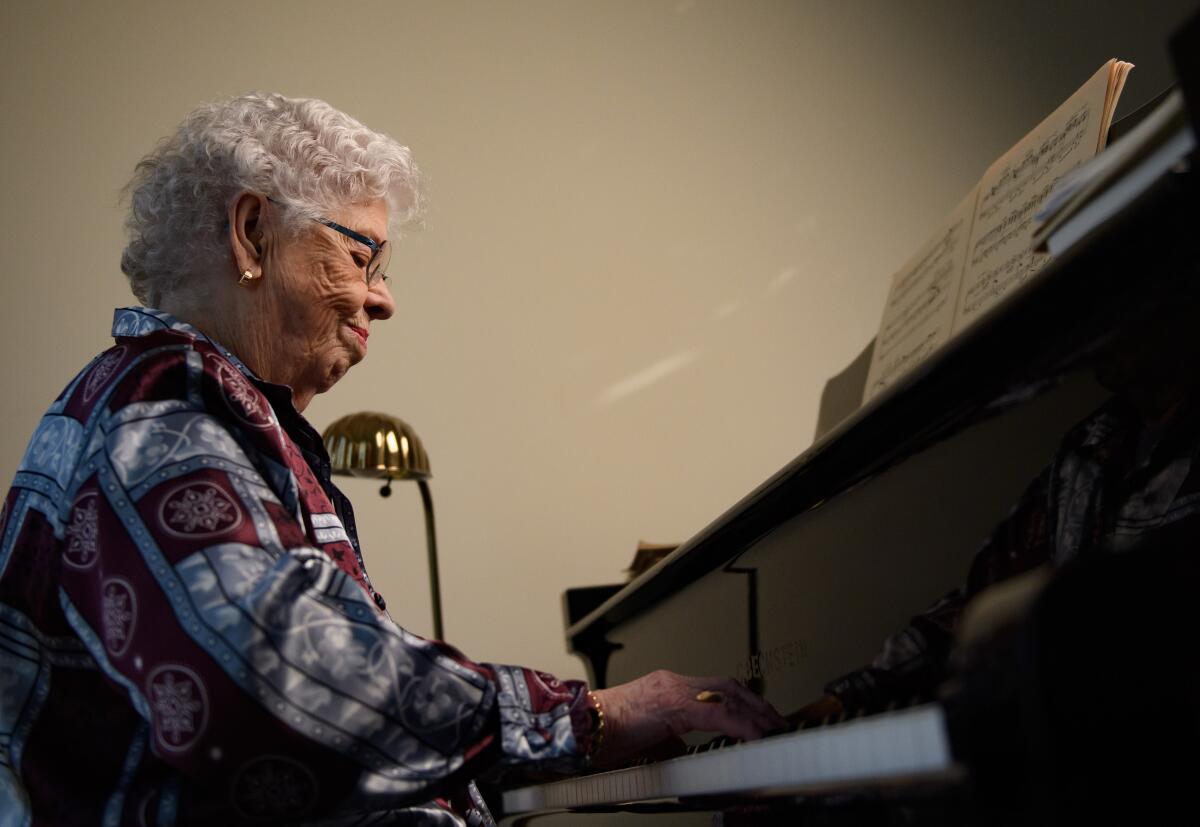
Though Joanne was a respected professional concert duo-pianist, her husband, of course, was the one whom everyone recognized out in Pittsburgh. She never resented him for his fame, she said, focusing instead on her piano and staying out of his work at PBS. But since his death, she’s felt an obligation to continue spreading his message because of how important she feels it is.
For the recent movie, Joanne spent time with many in the production, even giving Hanks some of Fred’s old ties to wear. She had a chair on the set but didn’t use it much because she found the endless takes “dullsville.” She was also one of five to vet the screenplay, though she said she didn’t make many changes. In one scene — in which she is played by Maryann Plunkett — a line of dialogue initially had her calling someone “buster,” and she objected to that.
“Something about ‘Watch out, buster!’ And I’ve never in my life said ‘buster’ to anybody,” she said with a laugh. Her only other note? She thought Plunkett’s wig was bad.
Something that didn’t make it into the film? The fact that Fred reveled in her dirty jokes. “He was not prissy. Not at all,” she said. “He ran around the house in the droopiest drawers. They were at least three sizes too big, but they were comfortable, and he liked them. It didn’t matter if there was company here — he’d wear those and a T-shirt. He was not a modest person.”
She got up to show me around the house, making note of a painting of the couple’s “Crooked House” on Nantucket and a “143” yellow production sign from the Hanks film. She kept her MacBook Air at a desk in the kitchen, where she wrote most of her emails.
“It keeps me in touch,” she said. “I can’t follow everything that’s going on. The movie stars all look alike to me now. I can remember their names — Aniston and this one and that one. I still haven’t figured out what it is that Kardashian does. What I’ve enjoyed most is Lady Gaga and what she’s done with her talent. How she can do anything she wants by just being crazy, funny-looking in outfits, you know? I think that is really smart.”
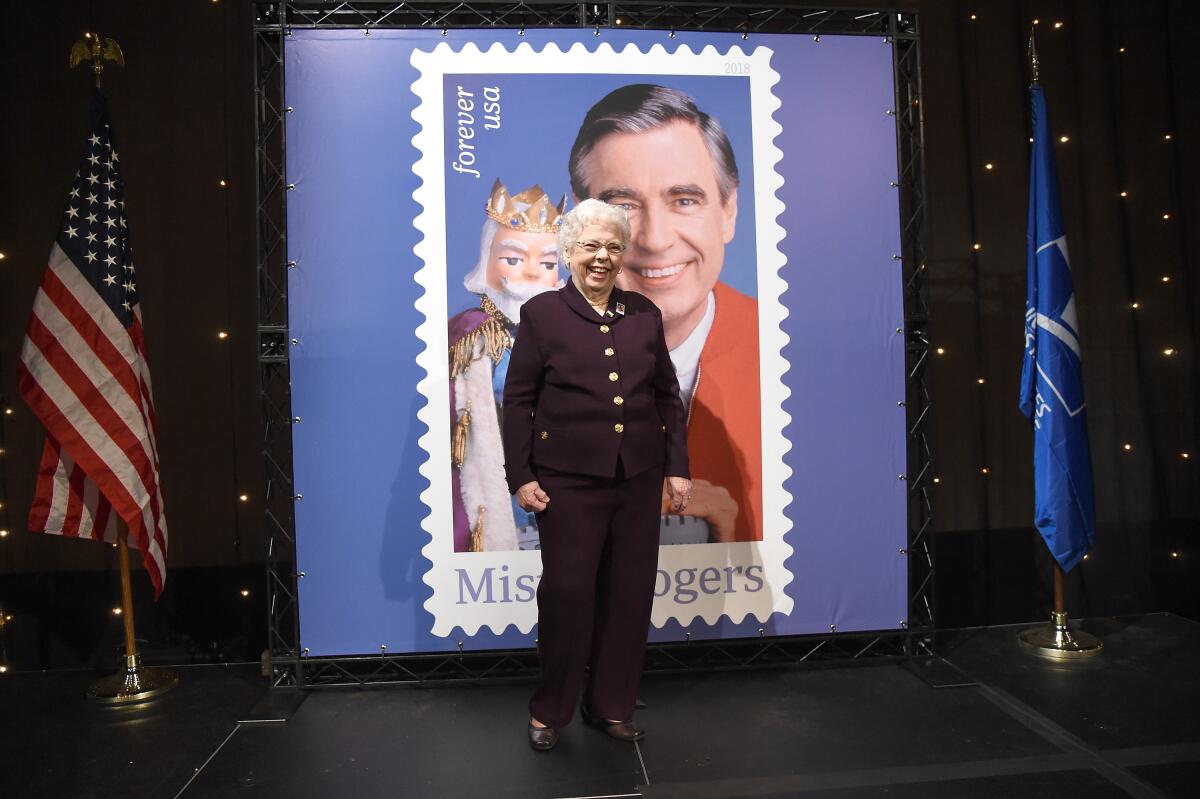
It was almost time for Joanne’s own Hollywood moment, so I left her to prepare for the evening’s premiere. Later, when we met up at the SouthSide Works Cinema, she had changed into a floral top and was carrying a gold Coach bag a friend had sent her specifically for movie-related events. As a Sony publicist tried to bring her toward the red carpet, she was besieged by guests wanting to greet her: her personal trainer, the local film commissioner and former Steelers running back Franco Harris. Nearly every reporter asked to pose for a photograph with her after their interview. Pam Surano, with CBS Pittsburgh’s KDKA News, started crying as Joanne walked away.
“I remember doing my live shot during the Tree of Life tragedy, and then someone pointed out that I was standing right in front of Fred’s old church,” a teary Surano told me, referring to the Sixth Presbyterian Church he attended a few blocks from the synagogue where 11 were killed during the deadliest mass shooting against Jews in the U.S. “There was something about that moment — needing him in that moment — that was so overwhelming and beautiful. Mrs. Rogers is right — he’s with everyone here all the time. It’s the truth. We carry him with us.”
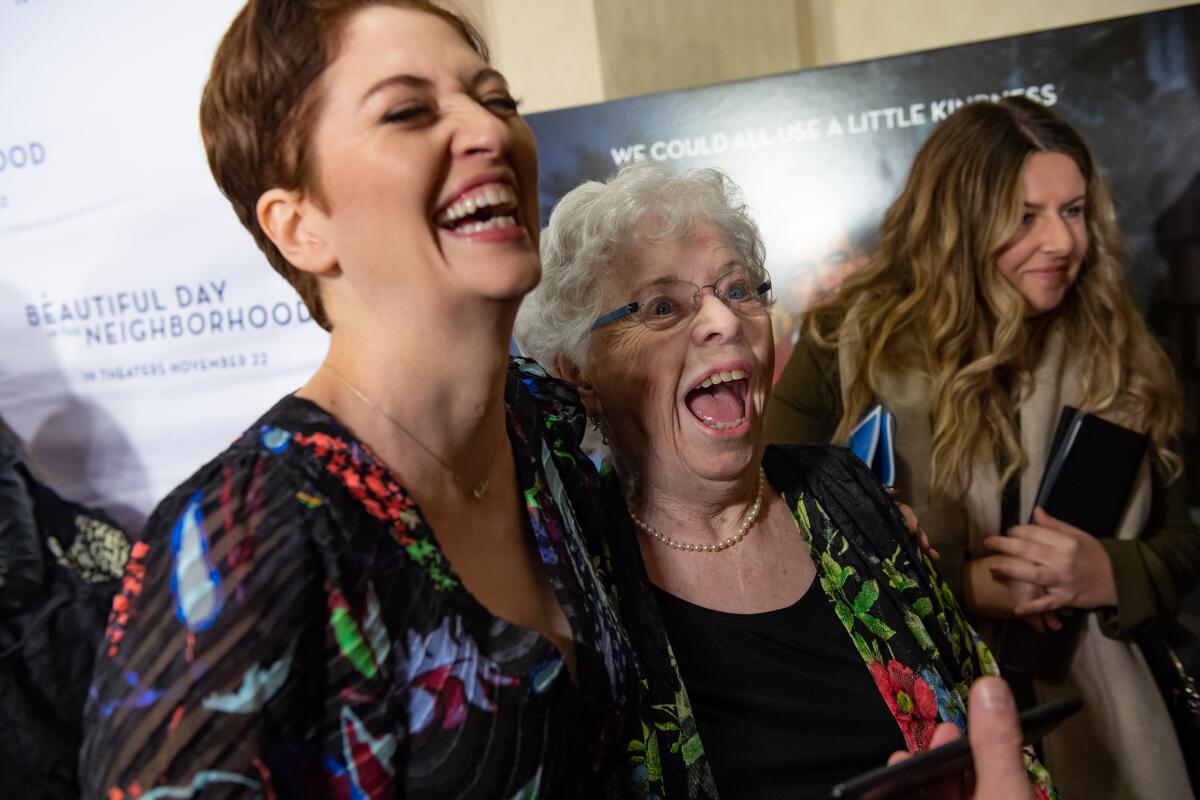
As Joanne entered the auditorium, the audience rose to its feet to give her a standing ovation. She sat through the screening — her third time seeing it — next to one of her sons, Jim, who had yet to see the movie. A row behind them, I watched as Jim wiped away tears throughout the movie.
“Spot on,” he said as the credits rolled. “I don’t know how Tom did it.”
Before she became too overwhelmed by well-wishers — even Mayor Bill Peduto crouched down next to Joanne’s movie seat — her Sony escort returned to bring her to a waiting car. I followed behind, not ready to say goodbye.
More on Mr. and Mrs. Rogers
“I love you,” she said, as we hugged again. “Bless your heart.”
On the flight home, I became oddly emotional thinking about Fred and Joanne — about how much they’d affected so many simply by expressing genuine care and kindness toward their neighbors. As she told the moviemakers, Fred wasn’t a saint. Since his death, she feels as if he’s been placed on an even higher pedestal. And she doesn’t like it.
“He’s out there now as somebody who’s somehow way above all the rest of us,” she said. “People invariably say, ‘Well, I can’t do that, but I sure do admire him. I would love to do it.’ Well, you can do it. I’m convinced there are lots of Fred Rogerses out there.”
More to Read
Only good movies
Get the Indie Focus newsletter, Mark Olsen's weekly guide to the world of cinema.
You may occasionally receive promotional content from the Los Angeles Times.

